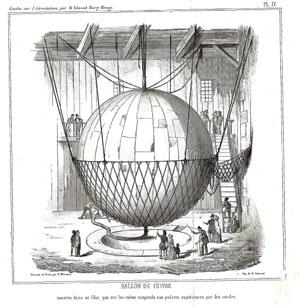
Are these flights of fantasy predecessors of the mystery airships that haunted the US and Europe in the late 19th century?
In 1844, Parisians with an extra franc in their pocket could wander to the outskirts of the city and buy entry to a mysterious building on Impasse du Maine, a narrow dead-end street just behind the new railway station at Montparnasse. Inside a cavernous hangar, proprietor Edmond Marey-Monge and his team of workmen laboured away, soldering together long sheets of metal to make a giant sphere. Just what this contraption was for only became clear after examining the blueprints: valves for introducing hydrogen and attachments for a passenger gondola hinted at a new mode of transport. The gleaming sphere, Marey-Monge announced, was a “ballon de cuivre” – a brass balloon.
METAL airships are one of the oldest notions in aeronautics. As early as 1670, Italian mathematician Francesco Lana published his Demonstration of the Feasibility of Constructing a Ship With Rudder and Sails, Which Will Sail Through the Air. Lana proposed evacuating the air from a set of copper spheres, which he reasoned would weigh less than the surrounding air and would ascend until the weight of the sphere reached equilibrium with the surrounding atmosphere. He calculated that four vacuum spheres, each with a diameter of 7.5 metres, could lift a boat carrying six passengers.
Full story by Paul Collins in New Scientist.